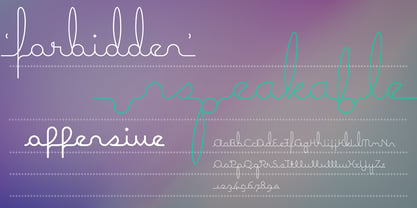Wählen Sie diesen Lizenztyp, wenn Sie eine app für iOS, Android oder Windows Phone entwickeln und Sie die Datei Font in den Code Ihrer mobilen Anwendung einbetten.
Expletive Script
von Barnbrook Fonts




- Aa Glyphen
-
Bestes AngebotFamilienpakete
- Einzelschnitte
- Technische Daten
- Lizenzierung
Per Font:
$30.00
Paket mit 4 Fonts:
$120.00
Über die Schriftfamilie Expletive Script
Expletive Script ist eine modulare Font , die auf einer Kreisform basiert. Die Zeichen können über oder unter der Grundlinie angeordnet werden, um ungewöhnliche Display-Typografie und komplexe, sich wiederholende Muster zu schaffen. Expletive Script hat einen spielerischen Geist und eine einfache Geometrie, die sie für eine Vielzahl von Anwendungen von feinen Details bis zu ausdrucksstarken Überschriften geeignet macht.
Designer: Marcus Leis Allion, Jonathan Barnbrook
Herausgeber: Barnbrook Fonts
Foundry: Barnbrook Fonts
Original Foundry: unknown
Eigentümer des Designs: Barnbrook Fonts
MyFonts Debüt: August 18, 2003
Über Barnbrook Fonts
Die Font Foundry von Designer Barnbrook und Jonathan Barnbrook, früher bekannt als Virusfonts. Schöpfer von Emigre Fonts Exocet, Mason und Priori. Designer von David Bowie Plattencovern. Ikonoklastische Zusammenarbeit mit Damien Hirst und Adbusters. Branding für große Museen, Locations und Kunstbiennalen. Das Studio hat seinen Sitz in London und arbeitet weiterhin an einer Vielzahl von kulturellen und musikalischen Projekten und Museumsausstellungen.
Mehr lesen
Weniger lesen